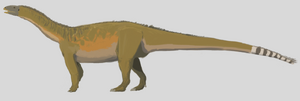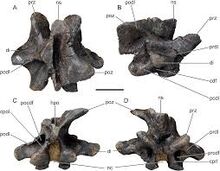
Hypothetical restoration, showing Kholumolumo in an outdated quadrupedal pose

Vertebrae
Kholumolumo (referring to a mythical dragon associated with dinosaurs by the Basuto people of Lesotho) is a genus of sauropodomorph from the Late Triassic (Carnian to Norian stage) Elliot Formation of Maphutsneg, Lesotho. Its remains were initially discovered in the immediate vicinity of a refuse pile in 1955, which would lead to the animal's informal description as "Thotobolosaurus mabeatae" ("Mabeata's trash heap lizard") in 1970. The original name originates from the location of the remains and Mabeata ("Mother of Beata" in Sesotho), an elderly woman and local resident of the western Lesotho village of Maphutseng who owned the trash pile near which the remains were found. However, this name remained informal for years. It was again informally described as "Kholumolumosaurus ellenbergerorum" in an unpublished dissertation in 1966. It was finally officially described as Kholumolumo ellenbergerorum in 2020. It is both the most complete and the largest sauropodomorph known from the Elliot Formation, as adults are estimated to have reached a length of 9 meters (30 feet). Despite its large size, its remains show that it was clearly bipedal. Its closest known relative is Sarahsaurus from Arizona.

